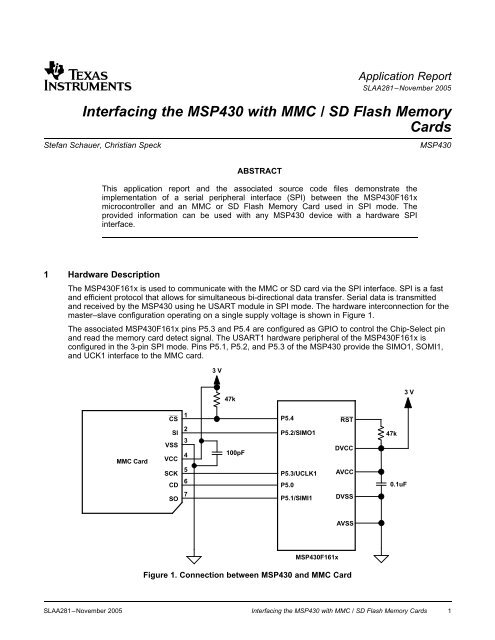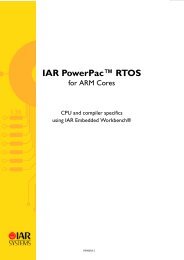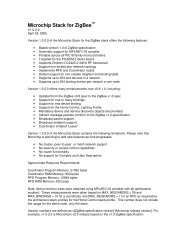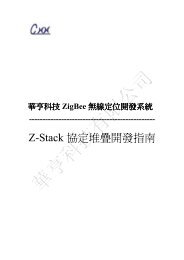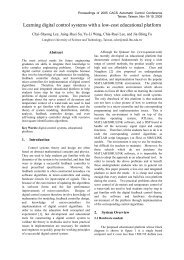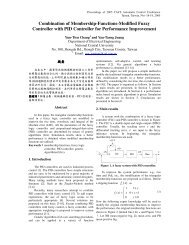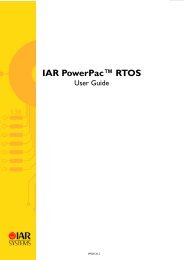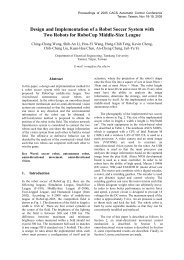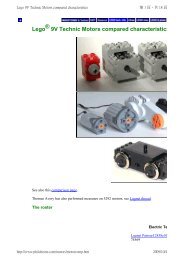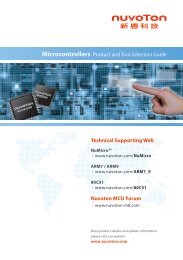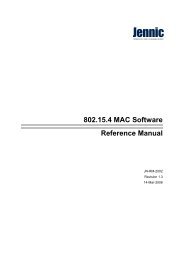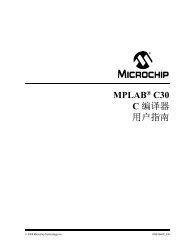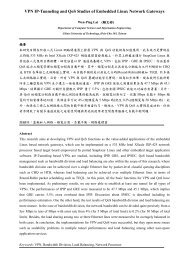Interfacing the MSP430 with MMC / SD Flash Memory Cards
Interfacing the MSP430 with MMC / SD Flash Memory Cards
Interfacing the MSP430 with MMC / SD Flash Memory Cards
You also want an ePaper? Increase the reach of your titles
YUMPU automatically turns print PDFs into web optimized ePapers that Google loves.
Application ReportSLAA281–November 2005<strong>Interfacing</strong> <strong>the</strong> <strong>MSP430</strong> <strong>with</strong> <strong>MMC</strong> / <strong>SD</strong> <strong>Flash</strong> <strong>Memory</strong><strong>Cards</strong>Stefan Schauer, Christian Speck.............................................................................................. <strong>MSP430</strong>ABSTRACTThis application report and <strong>the</strong> associated source code files demonstrate <strong>the</strong>implementation of a serial peripheral interface (SPI) between <strong>the</strong> <strong>MSP430</strong>F161xmicrocontroller and an <strong>MMC</strong> or <strong>SD</strong> <strong>Flash</strong> <strong>Memory</strong> Card used in SPI mode. Theprovided information can be used <strong>with</strong> any <strong>MSP430</strong> device <strong>with</strong> a hardware SPIinterface.1 Hardware DescriptionThe <strong>MSP430</strong>F161x is used to communicate <strong>with</strong> <strong>the</strong> <strong>MMC</strong> or <strong>SD</strong> card via <strong>the</strong> SPI interface. SPI is a fastand efficient protocol that allows for simultaneous bi-directional data transfer. Serial data is transmittedand received by <strong>the</strong> <strong>MSP430</strong> using he USART module in SPI mode. The hardware interconnection for <strong>the</strong>master–slave configuration operating on a single supply voltage is shown in Figure 1.The associated <strong>MSP430</strong>F161x pins P5.3 and P5.4 are configured as GPIO to control <strong>the</strong> Chip-Select pinand read <strong>the</strong> memory card detect signal. The USART1 hardware peripheral of <strong>the</strong> <strong>MSP430</strong>F161x isconfigured in <strong>the</strong> 3-pin SPI mode. Pins P5.1, P5.2, and P5.3 of <strong>the</strong> <strong>MSP430</strong> provide <strong>the</strong> SIMO1, SOMI1,and UCK1 interface to <strong>the</strong> <strong>MMC</strong> card.3 V47k3 V<strong>MMC</strong> CardCSSIVSSVCCSCKCDSO1234567100pFP5.4P5.2/SIMO1P5.3/UCLK1P5.0P5.1/SIMI1RSTDVCCAVCCDVSS47k0.1uFAVSS<strong>MSP430</strong>F161xFigure 1. Connection between <strong>MSP430</strong> and <strong>MMC</strong> CardSLAA281–November 2005 <strong>Interfacing</strong> <strong>the</strong> <strong>MSP430</strong> <strong>with</strong> <strong>MMC</strong> / <strong>SD</strong> <strong>Flash</strong> <strong>Memory</strong> <strong>Cards</strong> 1
Software Description2 Software Descriptionwww.ti.comThe code associated <strong>with</strong> this application note is designed as a driver set for communication between a<strong>MSP430</strong> and a <strong>MMC</strong> or <strong>SD</strong> card via <strong>the</strong> SPI bus as illustrated in <strong>the</strong> preceding hardware section. Thecode is written modular and can be reused easily. Note that only a subset of <strong>the</strong> available card commandsare used based on <strong>the</strong> limitations of <strong>the</strong> SPI interface and <strong>the</strong> secure functions of <strong>the</strong> <strong>SD</strong> Card.An example main() function is provided to illustrate proper use of <strong>the</strong> driver functions. It initializes <strong>the</strong><strong>MSP430</strong>F161x in <strong>the</strong> 3-pin SPI mode <strong>with</strong> <strong>the</strong> function init<strong>MMC</strong>(). The <strong>MSP430</strong> will <strong>the</strong>n poll until an <strong>MMC</strong>card is detected and try to read <strong>the</strong> device memory size. Upon <strong>the</strong> completion of this, <strong>the</strong> <strong>MSP430</strong>prepares a buffer <strong>with</strong> 512 bytes of data and writes it into two different sectors of <strong>the</strong> card. Finally, <strong>the</strong><strong>MSP430</strong> will read <strong>the</strong> data back that was written to each memory segment.After uncommenting <strong>the</strong> code line://#define <strong>with</strong>DMA<strong>the</strong> <strong>MSP430</strong>F161x DMA module will be used for data transmission between <strong>the</strong> <strong>MSP430</strong> and <strong>the</strong> <strong>MMC</strong>card, resulting in higher communication speed and less CPU load.If <strong>the</strong> software should be adopted to a different USART or a different device where <strong>the</strong> USART isconnected to o<strong>the</strong>r port pins following functions have to be checked for <strong>the</strong> correct settings:• void initSPI (void)• char init<strong>MMC</strong> (void)• mmc.h file3 Function Description3.1 char init<strong>MMC</strong> (void);Initializes <strong>the</strong> Port, SPI and <strong>the</strong> <strong>MMC</strong> Card. This routine may need to be adjusted if <strong>the</strong> library should beadopted to ano<strong>the</strong>r <strong>MSP430</strong> type or to ano<strong>the</strong>r USART module. Also some of <strong>the</strong> control signals could beset to a different port if necessary.Parameter:NoneReturn: Status Error/success code3.2 char mmc_ping(void);Check if <strong>MMC</strong> card is present.Parameter: NoneReturn: Status Error/success code3.3 void mmcSendCmd (const char cmd, unsigned long data, const char crc);Send a command to <strong>the</strong> <strong>MMC</strong> card.Parameter: cmd Command which should be sent to <strong>the</strong> <strong>MMC</strong> cardReturn:datacrcNoneData for <strong>the</strong> commandChecksum for <strong>the</strong> command2 <strong>Interfacing</strong> <strong>the</strong> <strong>MSP430</strong> <strong>with</strong> <strong>MMC</strong> / <strong>SD</strong> <strong>Flash</strong> <strong>Memory</strong> <strong>Cards</strong> SLAA281–November 2005
www.ti.comFunction Description3.4 char mmc_GoIdle();Set <strong>the</strong> <strong>MMC</strong> Card in Idle mode to save current.Parameter: NoneReturn: Status Error/success code3.5 char mmcSetBlockLength (const unsigned long);Set <strong>the</strong> <strong>MMC</strong> block length of count=2 n Byte. Normally this command is not required. The default blocklength is 512 byte.Parameter:Block Length of count=2 n ByteReturn: Status Error/success code3.6 char mmcReadBlock(const unsigned long address, const unsigned long count,unsigned char *pBuffer);#define mmcReadSector(sector, pBuffer) mmcReadBlock(sector × 512, 512, pBuffer)Read a size Byte big block beginning at <strong>the</strong> address.Parameter: address Start address of data to read on <strong>the</strong> cardcount Number of bytes to readpBuffer Pointer to read bufferReturn: Status Error/success code3.7 char mmcWriteBlock (const unsigned long address, const unsigned long count,unsigned char *pBuffer);#define mmcWriteSector(sector, pBuffer) mmcWriteBlock(sector × 512, 512, pBuffer).Write a 512 byte big block beginning at <strong>the</strong> (aligned) addressParameter: address Start address of data to read on <strong>the</strong> cardcount Number of bytes to writepBuffer Pointer to write bufferReturn: Status Error/success code3.8 char mmcReadRegister (const char cmd_register, const unsigned char length,unsigned char *pBuffer);Read <strong>the</strong> Register arg1 <strong>with</strong> Length arg2 (into <strong>the</strong> buffer).Parameter: cmd_register Register to readlength Number of bytes to readpBuffer Pointer to read bufferSLAA281–November 2005 <strong>Interfacing</strong> <strong>the</strong> <strong>MSP430</strong> <strong>with</strong> <strong>MMC</strong> / <strong>SD</strong> <strong>Flash</strong> <strong>Memory</strong> <strong>Cards</strong> 3
www.ti.comReferencesReturn: Status Error/success code3.9 unsigned long <strong>MMC</strong>_ReadCardSize(void);Read <strong>the</strong> Card Size from <strong>the</strong> C<strong>SD</strong> Register.Parameter:Return:NoneDetected Card Size4 References1. <strong>MSP430</strong>x169 Mixed Signal Microcontroller Data Sheet (SLAS368)2. <strong>MSP430</strong>x1xx Family User’s Guide (SLAU049)3. SanDisk MultiMediaCard Product Manual (SanDisk, 2001)4 <strong>Interfacing</strong> <strong>the</strong> <strong>MSP430</strong> <strong>with</strong> <strong>MMC</strong> / <strong>SD</strong> <strong>Flash</strong> <strong>Memory</strong> <strong>Cards</strong>SLAA281–November 2005
IMPORTANT NOTICETexas Instruments Incorporated and its subsidiaries (TI) reserve <strong>the</strong> right to make corrections, modifications,enhancements, improvements, and o<strong>the</strong>r changes to its products and services at any time and to discontinueany product or service <strong>with</strong>out notice. Customers should obtain <strong>the</strong> latest relevant information before placingorders and should verify that such information is current and complete. All products are sold subject to TI’s termsand conditions of sale supplied at <strong>the</strong> time of order acknowledgment.TI warrants performance of its hardware products to <strong>the</strong> specifications applicable at <strong>the</strong> time of sale inaccordance <strong>with</strong> TI’s standard warranty. Testing and o<strong>the</strong>r quality control techniques are used to <strong>the</strong> extent TIdeems necessary to support this warranty. Except where mandated by government requirements, testing of allparameters of each product is not necessarily performed.TI assumes no liability for applications assistance or customer product design. Customers are responsible for<strong>the</strong>ir products and applications using TI components. To minimize <strong>the</strong> risks associated <strong>with</strong> customer productsand applications, customers should provide adequate design and operating safeguards.TI does not warrant or represent that any license, ei<strong>the</strong>r express or implied, is granted under any TI patent right,copyright, mask work right, or o<strong>the</strong>r TI intellectual property right relating to any combination, machine, or processin which TI products or services are used. Information published by TI regarding third-party products or servicesdoes not constitute a license from TI to use such products or services or a warranty or endorsement <strong>the</strong>reof.Use of such information may require a license from a third party under <strong>the</strong> patents or o<strong>the</strong>r intellectual propertyof <strong>the</strong> third party, or a license from TI under <strong>the</strong> patents or o<strong>the</strong>r intellectual property of TI.Reproduction of information in TI data books or data sheets is permissible only if reproduction is <strong>with</strong>outalteration and is accompanied by all associated warranties, conditions, limitations, and notices. Reproductionof this information <strong>with</strong> alteration is an unfair and deceptive business practice. TI is not responsible or liable forsuch altered documentation.Resale of TI products or services <strong>with</strong> statements different from or beyond <strong>the</strong> parameters stated by TI for thatproduct or service voids all express and any implied warranties for <strong>the</strong> associated TI product or service andis an unfair and deceptive business practice. TI is not responsible or liable for any such statements.Following are URLs where you can obtain information on o<strong>the</strong>r Texas Instruments products and applicationsolutions:ProductsApplicationsAmplifiers amplifier.ti.com Audio www.ti.com/audioData Converters dataconverter.ti.com Automotive www.ti.com/automotiveDSP dsp.ti.com Broadband www.ti.com/broadbandInterface interface.ti.com Digital Control www.ti.com/digitalcontrolLogic logic.ti.com Military www.ti.com/militaryPower Mgmt power.ti.com Optical Networking www.ti.com/opticalnetworkMicrocontrollers microcontroller.ti.com Security www.ti.com/securityTelephonywww.ti.com/telephonyVideo & Imaging www.ti.com/videoWirelesswww.ti.com/wirelessMailing Address:Texas InstrumentsPost Office Box 655303 Dallas, Texas 75265Copyright © 2005, Texas Instruments Incorporated


